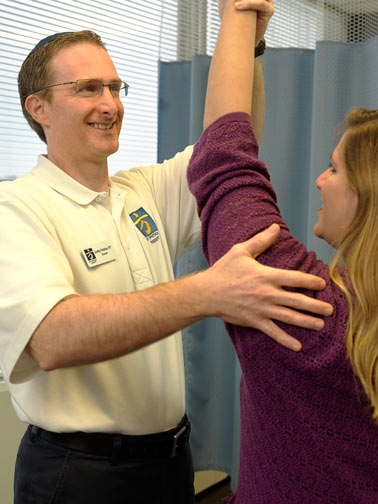Your physical therapist may have graduated from a prestigious accredited program and undoubtedly be highly skilled at what he or she does, but your progress throughout the course of your physical therapy treatments isn’t completely in the hands of your therapist. By taking responsibility for your recovery and/or improvement, you will be able to get the most out of your physical therapy treatments. Below you will find 5 tips that can help you, help yourself, when it comes to your progress in physical therapy.
1. Keep a journal specifically for your pain. It might seem like such a pain to jot down notes in a journal every single time you experience pain, but trust me it can be helpful. The more description you have in your journal the better. Be sure to write down the date, time, activity you were performing, and level and type of pain you felt. Simply writing “July 20th my leg was hurting pretty badly” won’t be as helpful as writing “July 20th 5:35pm I was walking up a short flight of stairs when my leg began to have an intense throbbing pain. I would rate my pain as a 7 on a scale of 1 to 10”. Not only can a detailed journal help you to keep track of your progress, it can also help you to more effectively communicate with your therapist the extent of your discomfort.
2. Stick with one physical therapist. This isn’t to say that if you feel your physical therapist isn’t performing adequately you should stick around anyway. It’s important that you are comfortable with your therapist and that you trust their opinion. But if competency isn’t an issue, request to work with the same physical therapist every time you go in for treatment. The professional who is treating you won’t have to start from square one asking basic preliminary questions or figuring out what methods works best for you.
3. Take notes of any information your physical therapist doesn’t have printed for you. Sometimes your therapist will provide you with illustrations and instructions for certain exercises you’ll need to perform at home, and sometimes he or she won’t. If your therapist doesn’t provide you with some type of handout, don’t try to commit the information to memory, write it down. That way when it comes time to perform the exercise, there will be no confusion as to whether or not you are doing it accurately. Performing an exercise the wrong way, more than you were supposed to, or less than you were supposed to can lead to a delay in your progress to recovery.
4. Heed the instruction/advice of your physical therapist. Mom doesn’t always know best. And that friend who had a similar injury and was much improved a short time after doing this or that, has a different body than you do. So although advice can be helpful, when it comes to your physical therapy routine and exercises, the best advice comes from your physical therapist. Sometimes you may contemplate forgoing your therapist advice and just doing what you think is best, but it’s important to keep in mind that your therapist endured years of training and has a good amount of experience in these matters.
5. If possible, take steps to prevent whatever injury landed you in physical therapy from reoccurring. Some physical therapy patients aren’t able to prevent whatever condition or injury resulted in their need for a therapist’ assistance, but if whatever injury you sustained can be prevented, learn what you can do to keep from getting hurt again. This could mean changes in lifestyle or changes in your normal exercise regimen.
Adhering to the tips listed above can drastically influence the progress that you make throughout the course of physical therapy. However, finding a physical therapist who is both skilled and passionate about their work, is the first step in the right direction. RPI Therapy is home to a number of highly trained physical therapists who are dedicated to exceeding the expectations of customers. For more information about RPI Therapy and the services we provide, click here.


